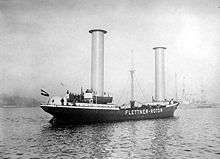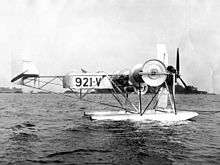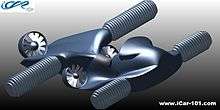Flettner rotor

A Flettner rotor is a smooth cylinder with disc end plates which is spun along its long axis and, as air passes at right angles across it, the Magnus effect causes an aerodynamic force to be generated in the third dimension.[1]
In a rotor ship the rotor stand vertical and lift is generated at right angles to the wind, to drive the ship forwards.
In a rotor airplane the rotor extends sideways in place of a wing and upwards lift is generated.
The Magnus effect
The Magnus effect is named after Gustav Magnus, the German physicist who investigated it. It describes the force generated by fluid flow over a rotating body, at right angles to both the direction of flow and the axis of rotation. This force on a rotating cylinder is known as Kutta–Joukowski lift, after Martin Wilhelm Kutta and Nikolai Zhukovsky (or Joukowski), who first analyzed the effect.[2]
The Flettner rotor is just one form of the Magnus rotor, which in general need not be cylindrical.[1]
Marine applications
Rotor ships
Rotor ships use mast-like cylinders for propulsion.
Stabilizers
A Flettner rotor mounted beneath the waterline of a ship's hull and emerging laterally will act to stabilize the ship in heavy seas. By controlling the direction and speed of rotation, strong lift or downforce can be generated.[3] The largest deployment of the system to date is in the motor yacht Eclipse.
Rotor airplanes

Some flying machines have been built which use the Magnus effect to create lift with a rotating cylinder at the front of a wing, allowing flight at lower horizontal speeds.[2] The earliest attempt to use the Magnus effect for a heavier-than-air aircraft was in 1910 by a US member of Congress, Butler Ames of Massachusetts. The next attempt was in the early 1930s by three inventors in New York state.[4]

The iCar 101 project propsed the use of Flettner rotors in roadable aircraft to combine compactness with high lift.[5][6]
References
- 1 2 Seifert, Jost; "A review of the Magnus effect in aeronautics", Progress in Aerospace Sciences Vol. 55, 2012, pp.17–45.
- 1 2 "Lift on rotating cylinders". NASA Glenn Research Center. 2010-11-09. Retrieved 2013-11-07.
- ↑ "Quantum Rotary Stabilizers". Jun 2, 2009.
- ↑ Whirling Spools Lift This Plane. Popular Science. Nov 1930. Retrieved 2013-02-22.
- ↑ "iCar 101 roadable aircraft". iCar-101.com. Retrieved 2014-12-01
- ↑ The Globe and Mail: A wingless flying car that drives like a motorcycle, November 2014